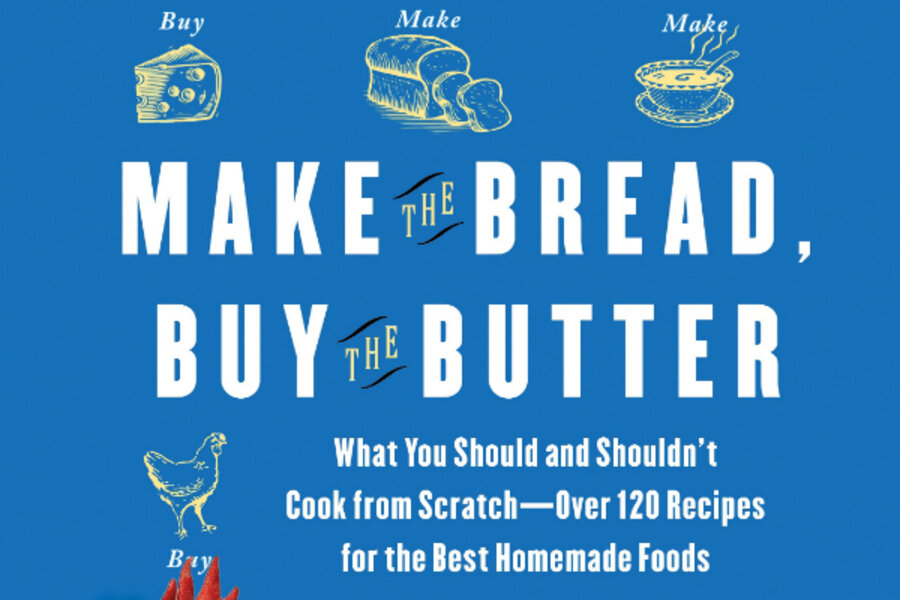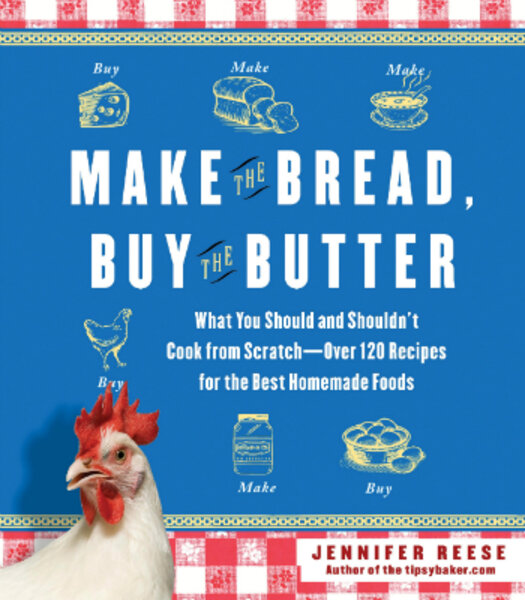Cookbook review: Make the Bread, Buy the Butter
Loading...
I’ve been meaning to tell you about this cookbook for awhile. For all those of you out there who are raising chickens, pickling, and making your own crackers, you’ll find good wit and wisdom in “Make the Bread, Buy the Butter” by Jennifer Reese (Free Press, October 2011, $24).
Having chickens cluck in the yard and filling your pantry with preserves that you picked and canned yourself is rewarding – but is it worth all the time battling persistent bugs and rodents just to say, “I made this sauce with heirloom tomatoes I grew myself”?
Reese, who blogs at www.tipsybaker.com, took on an ambitious project when she applied her journalistic skills to figure out what is worth making at home (croutons), what is worth attempting for the experience (Camembert cheese), and what is an accomplishment but a true pain in the rear (prosciutto).
“You don’t have to meekly accept what Safe or Stop ‘n’ Shop has to offer,” says Reese. “Cooking is easy and don’t let anyone tell you otherwise. On the other hand, don’t feel guilty when you buy something delicious that happens to come from a supermarket. Lays potato chips are better than any chips I’ve ever made by standing over a cauldron of hot oil. The perfectionist homespun/do-it-yourself/urban farming ethic some of us are susceptible to can become rather enslaving. I’m all about the middle ground. I’ve just tried to figure out exactly where that is.”
While tackling more than 120 recipes for everyday items made from scratch Reese does us all a big favor. She puts in the time to discover how much of a cost savings and a challenge it is to make your own Oreos, so we don’t have to. Reese also wisely counsels that sometimes picking up a rotisserie chicken is just as delicious as roasting your own, plus you’ll get a few more precious moments to put together a puzzle with your child and eating before 8 p.m. instead of dashing around and trying to recreate a dinner scene from a Norman Rockwell painting.
Reese’s tales told with a matter-of-fact humor will keep you entertained even if you have no plans to raise goats, ducks, or bees (Reese and her family do). Reese also lets herself to be changed by her experiment, giving up cherished ideals for the sanity of practicality, like the day she realized her free-ranging backyard chickens really need to be penned up for their safety and for health of the garden, which one morning “looked as if the entire patch had been stomped by the yeti.”
We decided we couldn’t let our chickens range around the yard anymore. Although the yard was secured by a tall wire fence, the sight of all those chickens drove the local predator population mad with bloodlust. I disapprove of factory farms, but I understand why people who depend on chickens for their livelihood might decide to keep them in a big, windowless room….
The chickens resented the coop. They paced their perimeter, yelling, looking out through the chicken wire. I liked them less almost immediately. I found them irritating with all their complaints and demands, and somewhat contemptible. I had an inkling of how becoming a prison guard might corrode the soul.
But I thought we were were all set, that our chickens were now safe. (p. 37)
The tale of the chickens, of course, doesn’t end there, and in the end Reese admits that her feathered “girls” are really more like an expensive hobby that provides her family with fresh eggs and hours of entertainment than a backyard sustainable food source.
I was thrilled to find a yogurt recipe in “Make the Bread, Buy the Butter” that doesn’t involve a yogurtmaker because I keep hearing how easy it is to make your own yogurt and how much money you save making it yourself instead of shelling out $6-$7 for a large carton at the grocery store. I did try Reese’s recipe, with no luck. For the record, I am a failure of a yogurtmaker and I seem destined to put this easy process into my “buy it” category. I’ve tried other homemade yogurt recipes to only end up with slightly curdled milk.
I guess I just have to accept that I am one of those overly scheduled urbanites whose fantasies of homesteading will have to be lived vicariously through others like Reese. I just don’ t have the time to babysit warm milk as it transforms into thick, creamy yogurt.
All in all, “Make the Bread, Buy the Butter” is a very useful and valuable collection of recipes ranging from the complex such as croissants to classic favorites such as pumpkin chocolate chip muffins to easy sauces such as mayonnaise. Like most food memoirs, readers also get a peek into Reese’s family life stirred with vignettes from her card-file of memories.
That alone makes Reese’s book worth reading – even if you really, really don’t have the time to make the bread.
Related posts on Kitchen Report: Are you an urban homesteader?, Chicken and Dumplings









